Where Does Corn Beef Come From the Cow or the Steer
In this commodity, we'll answer the question: What Is Brisket? Nosotros know it's 1 of the all-time meats for smoking, just exactly what is it? Where does it come from? What is the history of utilise for this cut of meat?
Vikings called it gristle or cartilage. In One-time English the give-and-take is brushk, meaning tough. You lot can just see a lot of serious gnawing going on, correct? Aye, proficient times.
Simply the brisket we know and love today is, well, centuries across what was served in drafty dining halls along with tankards of mead and ale. And thankfully so.
So let's dig in, and along the way take a close wait at 1 of the all-time transformation stories in meat cooking history.
Contents (Jump to Topic)
- 1 What Role of the Cow is Brisket?
- two What is Connective Tissue?
- two.1 Elastin
- 2.2 Collagen
- three Three Cuts of a Beef Brisket
- 3.ane Full Packer
- three.2 The Flat
- 3.three The Betoken
- 4 Where to Purchase Brisket Online
- 5 Where the Fat is and How Much to Trim
- vi Softening Up Ane Tough Customer
- 7 A Word on Corned Beef
- 8 A Word on Pastrami
- 9 The Many Means to Bring Out the Best in Brisket
- 9.ane Brisket in the Smoker
- 9.2 Brisket in the Oven
- 9.three Brisket the Sous Vide Way
- 9.iv Is There a Right Manner to Serve Brisket?
- 10 A Final Word on Safe Brisket
- xi Brisket — Tough No More
What Part of the Moo-cow is Brisket?
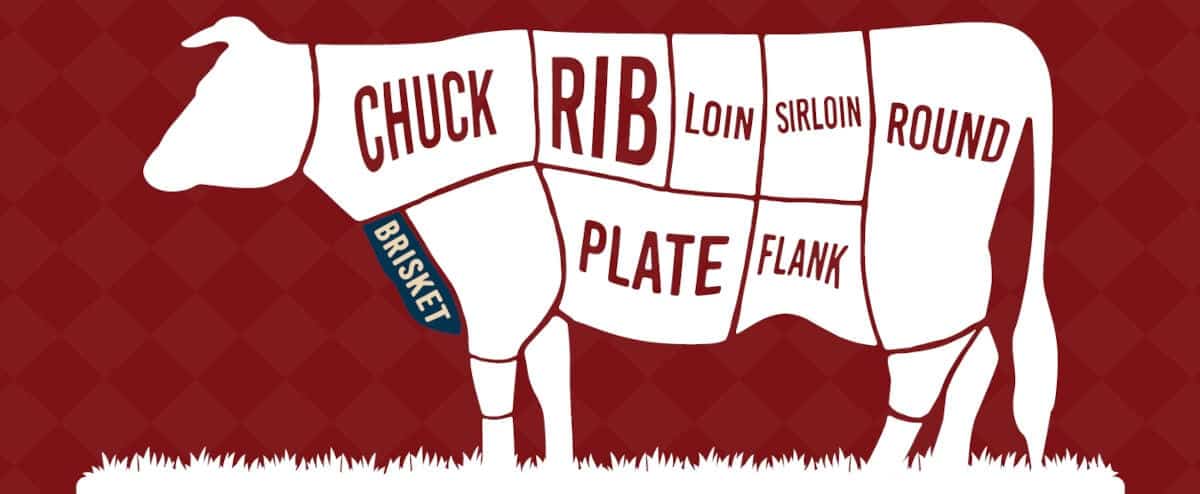
Brisket comes from beef (cows or steers aged 2-years and up) or veal (milk-fed beef calves aged two to 4 months).
If you lot're looking at the animal side-on, it's the area right above the front leg. Front on, information technology'southward the expanse between the front legs. This is chosen the breast, (lower) chest, or pectorals. (We take a detailed beef cuts nautical chart showing all popular cuts if interested.)
Cattle don't have collarbones which assist support the body's weight, so these pectoral muscles are all that'south keeping the front half of a ane,200 to 1,400-pound animal off the ground. Supporting about sixty percent of the animal's weight calls for dense and tough musculus. Which is why it consists generally of connective tissue.
You can see where the brisket comes from on the moo-cow, and many tips and tricks from the pros on how to prepare and cook a brisket, in the following video from Jess Pryles:
What is Connective Tissue?
Institute in tendons, silverskin, and ligaments is a rubber band-similar material which mainly works to hold musculus fiber and sheaths together. Too called cellular glue, they requite shape to and strengthen tissues. There are ii forms of connective tissue –
Elastin
A protein that is flexible and, well, elastic — able to stretch and resume its original shape. As it loses wet through crumbling or the cooking procedure, it tin can go brittle, tough, and unchewable — and chosen gristle.
Collagen
The almost abundant blazon of poly peptide in all mammals and one of the strongest.The Accidental Scientist of Exploratorium.edu explains collagen'south rope-like construction of 3 molecule chains braided together hold fiber and sheaths together. It as well makes collagen strong.
It's found in abundance in the legs, rump, and breast in cows and pigs. Information technology turns into gelatin in the cooking process.
The gelatin gives the meat a silky, moist texture. Too connective tissue, collagen is plant in ligaments, blood vessels, bone, and skin. Yes, the very affair whose absence brings on wrinkles and crêpey pare.
This combination protein team is the reason beefiness brisket must be cooked low and slow. The connective tissues relax, allowing water to evaporate instead of being squeezed out like wringing a sponge. And it takes fourth dimension for the collagen to intermission down with long exposure to heat, to eventually become gelatin.
Three Cuts of a Beef Brisket
As discussed in more depth in our article on brisket flat vs point, brisket is supplied 3 dissimilar ways:
Full Packer
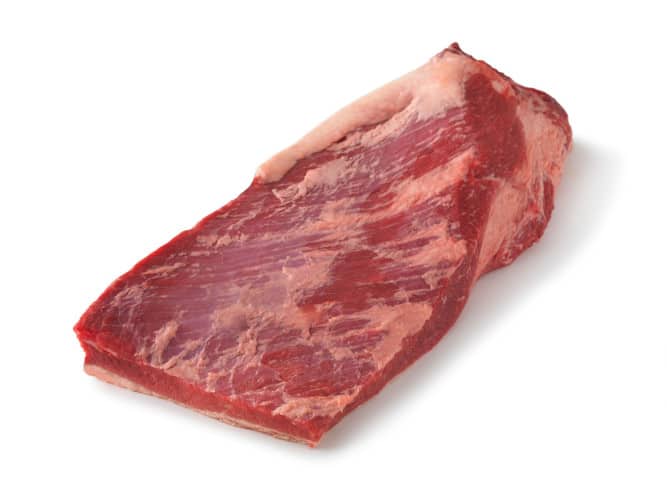
This is the whole brisket cut, made up of the two different muscles combined that are the Flat and the Point separated by a layer of fat. It weighs between 8 and 20 pounds. A layer of fatty covers the top; this fatty cap tin be trimmed to ¼ to i inches.
The Flat
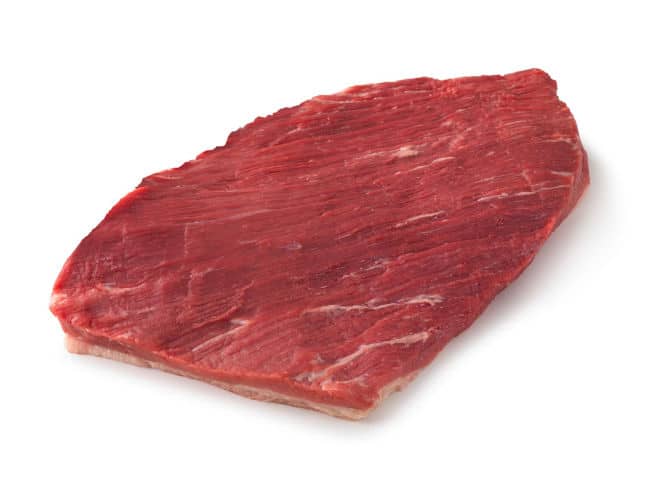
This is the main part of the brisket. Also known every bit the outset or flat cut or the deep pectoral, it lies toward the inside the moo-cow, confronting the ribs. Beingness worked the well-nigh, information technology is lean, or low on fat content. Information technology's typically used for corned beef and pastrami.
The Bespeak
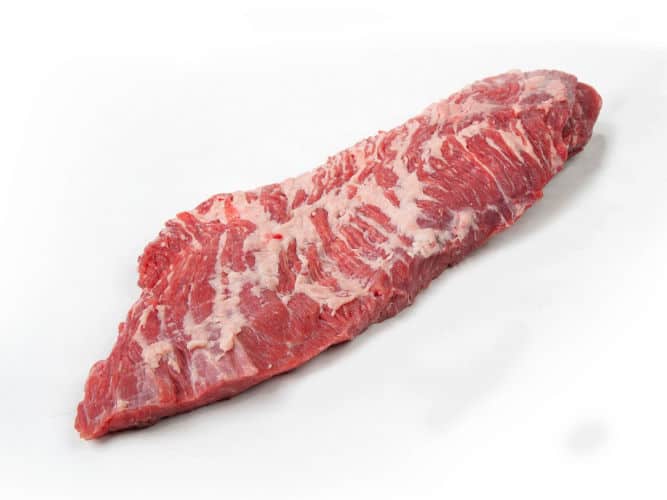
This is the lower portion which sits 'exterior' above the leg, it is the superficial pectoral. Also called the fat end or second, point, or triangular cut. It's typically used to make beef burnt ends.
Where to Buy Brisket Online
Snake River Farms
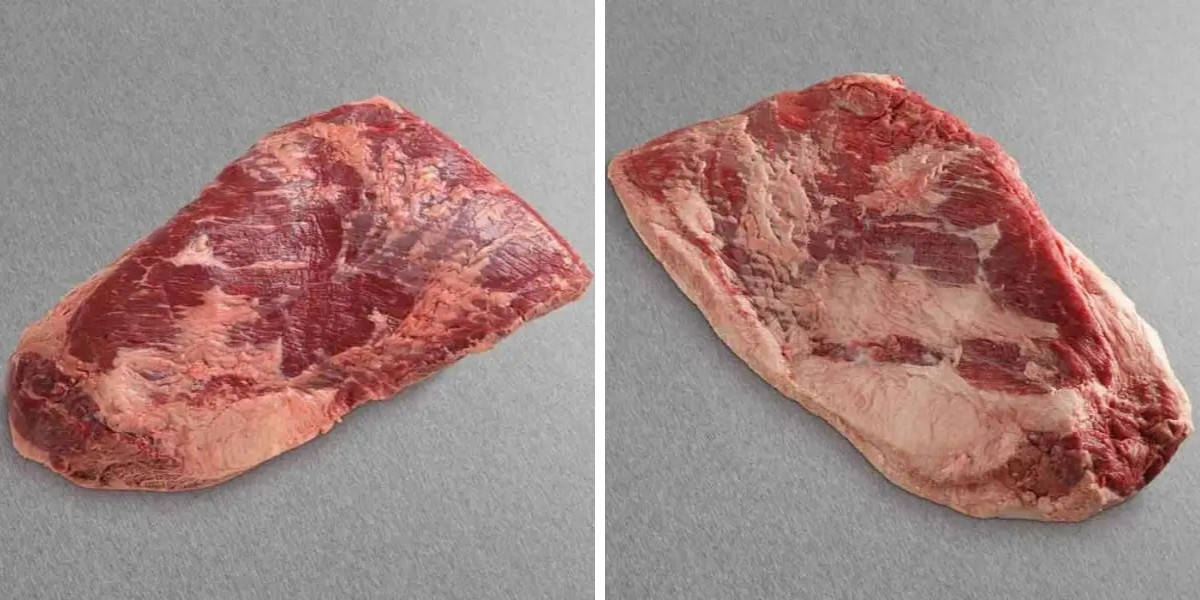
Brisket is available in two tiers at Ophidian River Farms:
- American Black Class Wagyu
- American Golden Grade Wagyu
The marbling score of black grade briskets is greater than that of USDA Prime. This Wagyu cross beef is raised in the Pacific Northwest'south temperate climate, resulting in briskets with naturally rich marbling and exceptional season.
Snake River Farms' Gold Course briskets are their almost premium line, with more intramuscular fat and marbling than their Blackness Grade briskets. So you can expect them to be rich and buttery, with a tonne of deep umami beef gustatory modality.
Briskets from Snake River Farms range in weight from nine-12 lbs to 20+ lbs.
Bank check Price on Snake River Farms
Porter Route
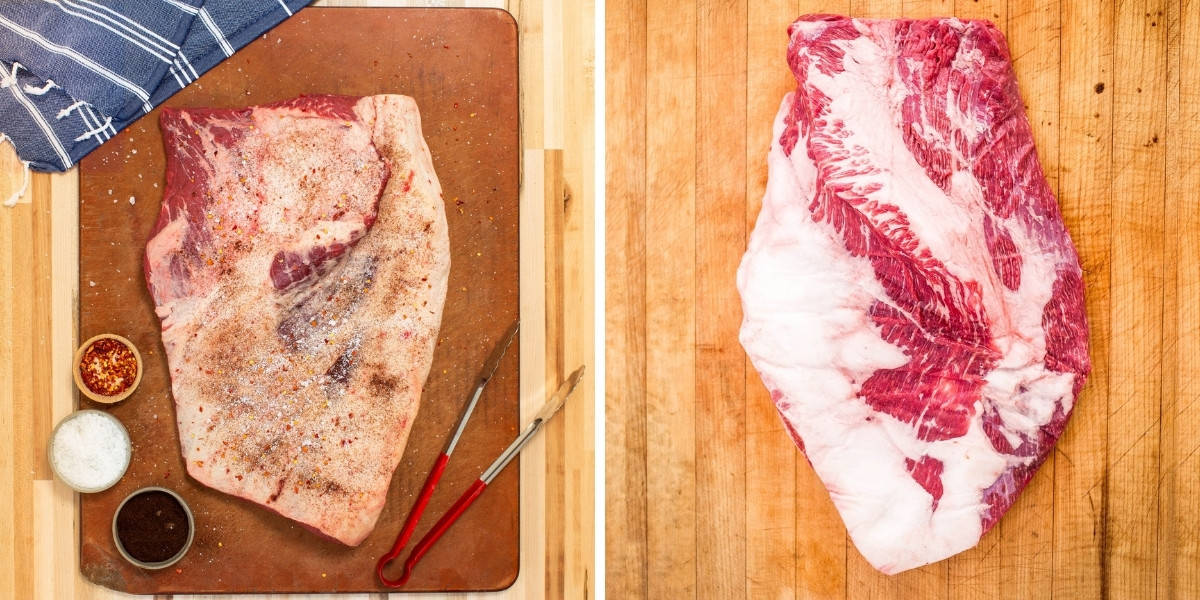
'Packer brisket' and 'whole brisket' are the ii varieties of brisket bachelor at Porter Road.
Their packer briskets counterbalance 13.5 to fourteen.5 pounds, whereas their whole briskets weigh between 8 and 10 pounds.
I'chiliad not sure why they have unlike names as they are both 'whole brisket,' but they exercise have different weights and come from unlike farms.
Both briskets are richly marbled and tasty, and then they won't let y'all downwards. Porter Route's briskets are delivered frozen to proceed them fresh.
Check Cost on Porter Road
Where the Fat is and How Much to Trim
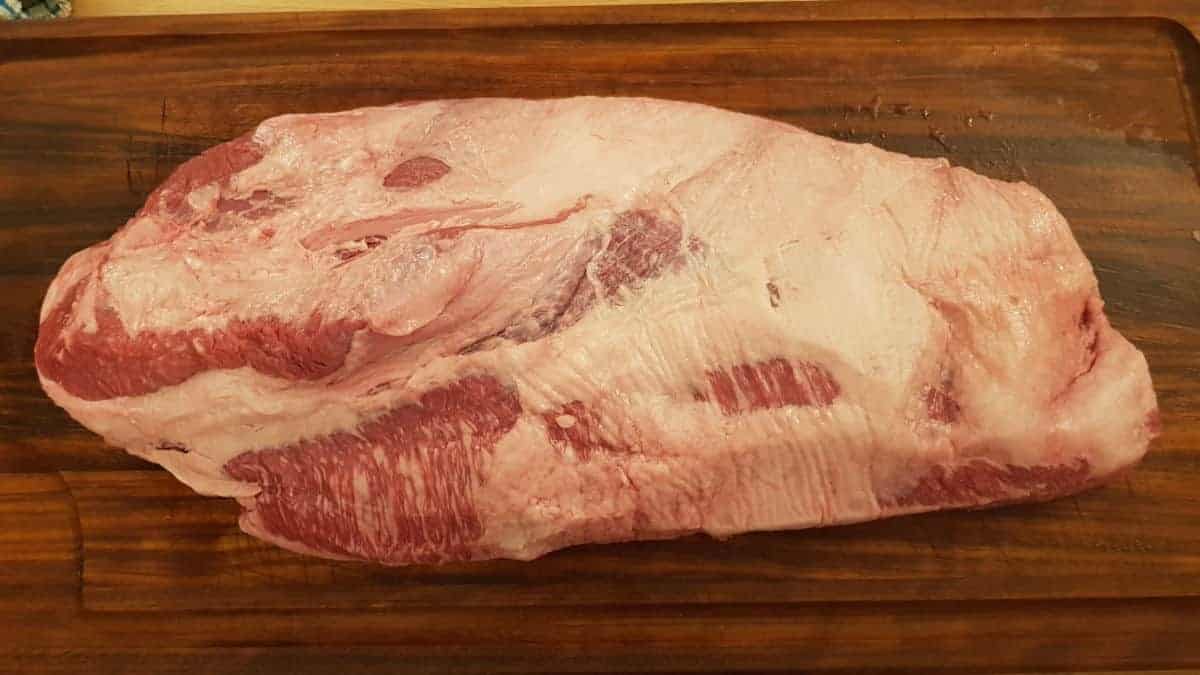
Fat should be white in color and evenly distributed throughout the brisket, advises Chefsteps.com, a resources for professional chefs. The website displays a good picture of what non to become.
Never completely remove the fat. Every bit discussed in our commodity on whether to smoke brisket fatty side upwards or downwardly, information technology's important for the cooking process, helping to prevent drying out. If having the brisket professionally trimmed, the terms to know are:
Packer — entire fat cap left intact
Trimmed or Super-Trimmed — depending on whom y'all ask, this is leaving on one-half to an inch (ane/2"–1") of fat.
The fat and the depression-n-slow cooking method are what make the deviation betwixt gnawing gristle with great exertion and chewing brisket, relaxed and blissfully happy. Cheque out our guide on how to trim brisket for how to get the all-time results.
Keep reading to acquire how the toughest part of the cow became the most prized.
Softening Upwardly One Tough Client
In that location was a fourth dimension when tough, chewy, and stringy were commonly used words to describe a cooked brisket. So information technology was left behind at the meat processing found. No one believed anyone would buy it on purpose. But there's always someone hungry enough to accept what'due south considered the worst of meat and put it to the fire.
At some point in time, it was 'discovered' that the low-and-tedious cooking method — perhaps boiling, stewing, or roasting — transformed those dense musculus fibers into a succulent, tender cut of meat.
Smoked brisket, says Max Bonem in Food & Wine magazine, dates back to the belatedly 17thursday century here in u.s. when Eastern European and Jewish immigrants traded ideas with local ranchers.
Just it wasn't until the 1960s that brisket became a standard cut commercially sold to restaurants and stores. Past the 1980s, need for it skyrocketed, and lines at restaurants with it equally the main attraction began extending around the corner. In that location are many workshops and fifty-fifty more competitions devoted to brisket, with it becoming nigh synonymous with Texas barbecue.
Only there's more to brisket than the smoker. There are two preservation methods (one moisture, 1 dry) which turn it into two cultural favorites: corned beef and pastrami.
A Give-and-take on Corned Beefiness
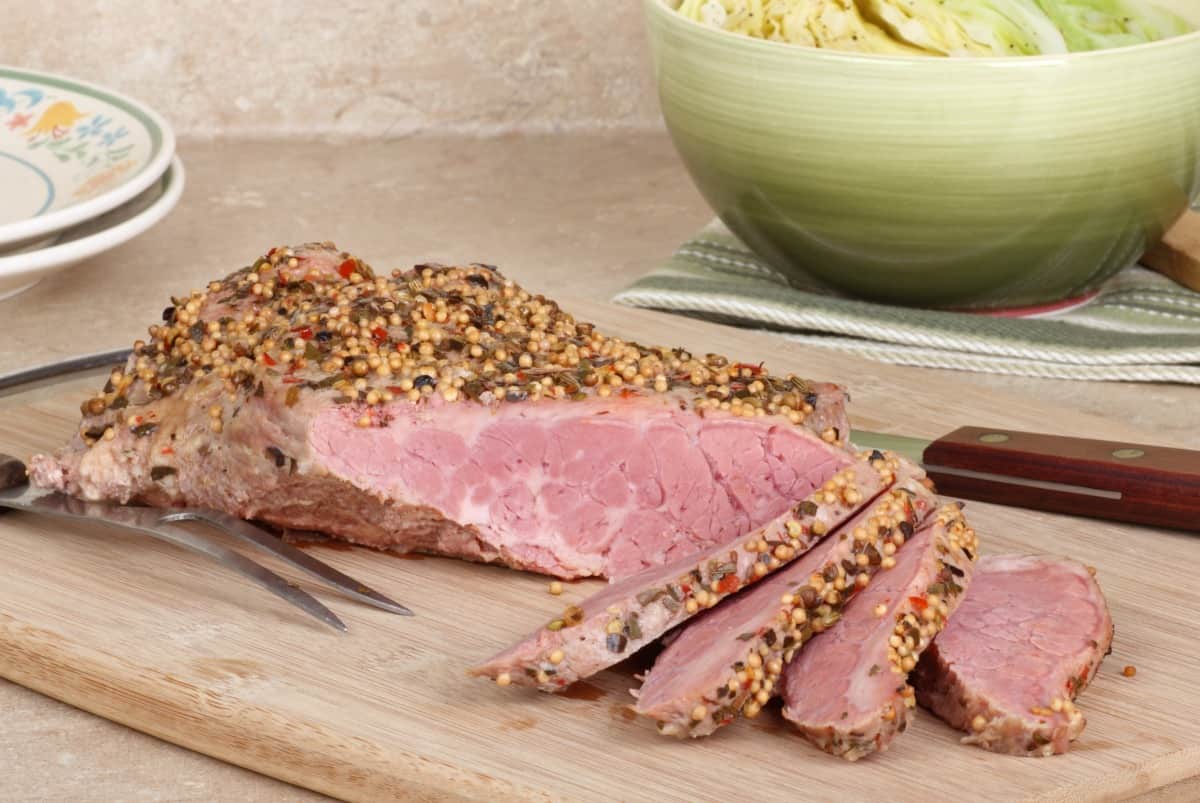
Fibroid rock table salt looks more than like grains or seeds than teeny crystals issuing from a nearby salt shaker.
Old dorsum in 1570 or 1580 Advert came the first recorded use of the word "corned" used to describe meat beingness preserved in a bath of common salt.
This wet preservation method commonly also includes things like peppercorn, garlic, and cloves. Today we call it moisture brining, or curing. We'll take a more detailed wait at this another time.
A Word on Pastrami
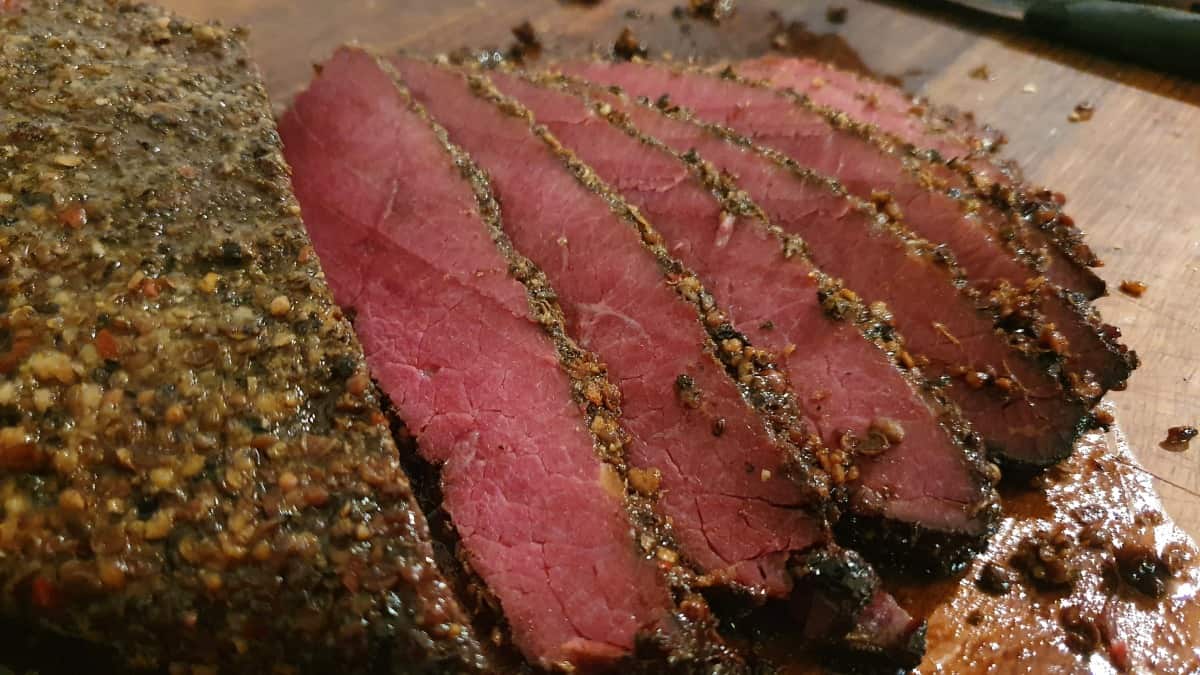
"Across the brine lies the smokehouse" could be the subtitle for The Story of Pastrami.
The name comes from the Romanaian word pastrami taken from pǎstra, which ways to preserve. This delicatessen staple takes the dry preservation road of a salt and spice cure followed past a stint in the smoker.
The trademark pink colour comes from the curing salt. This one also deserves its ain article, so more on this later.
The Many Ways to Bring Out the All-time in Brisket
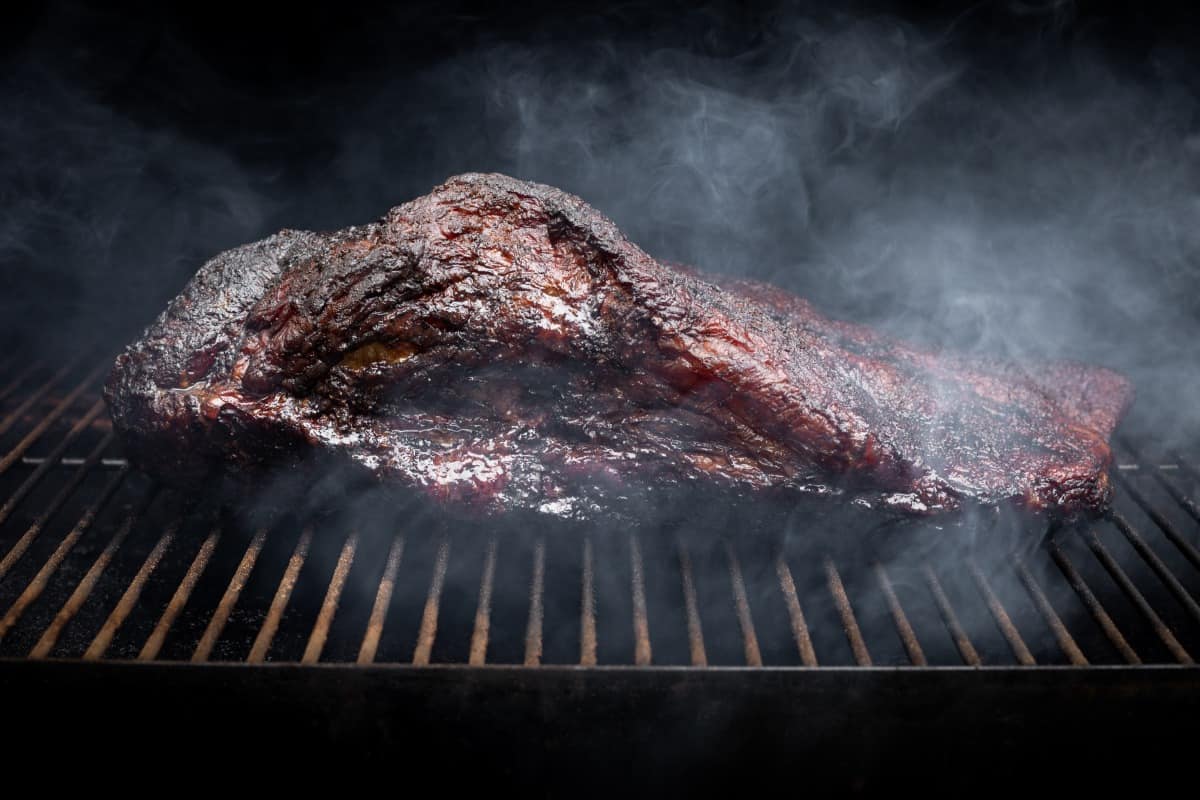
Brisket in the Smoker
We hash out smoking brisket at length elsewhere, then, for now, we'll just say that the process of seasoning (marinade / brisket injection), smoking (i to ane ½ hours per-pound at 250° F) and slicing brisket correctly leads to wonderful results.
Brisket in the Oven
Pot roast is another cultural favorite rendering of brisket. Quality fourth dimension in the oven or deadening cooker with carrots, onions, and — okay, I'll finish drooling if you will.
Some other cultural favorite, Betty Crocker, recommends for a 2½ to 4-pounder, roasting for 2½ to 3 hours covered in liquid at 325 °F until the internal temperature reaches 135° F. For a well-done brisket, carryover cooking should bring the heat upwards to 170° inside 15 minutes.
Brisket the Sous Vide Mode
A water bath at 131 to 133° F for ii to three days melts the collagen into gelatin, creating a tender roast.
Clint Caldwell of AmazingRibs.com explains the brisket will shrink by at to the lowest degree 40 pct in this cooking process.
After seasoning, the meat is placed into a heavy plastic bag and then vacuum-sealed. The airtight package goes into the water-filled sous vide cooker where the depression, steady temperature gently cooks the meat, turning it pink. It can be served to the tabular array straight from the cooker, only some will put a crust on it past searing it in a dry out skillet on the stove or under the broiler for a few minutes.
Clint explains how to create smoked sous vide brisket, a true written report in patience: Later trimming, dry brine the cut for 12 to 24 hours, sous-vided for 30 hours, and so rapidly chilled in a 50/l ice-water bath for a mere 30 minutes. At this point, information technology tin can be frozen or refrigerated until grill time.
Then, a 2-zone grill or smoker is fired upwards, the brisket leaves its plastic pouch and goes on the grate to be smoked for an hour at 225° F. Strain the juice in the bag to create an awesome sauce. And then, it's done.
Is There a Right Way to Serve Brisket?
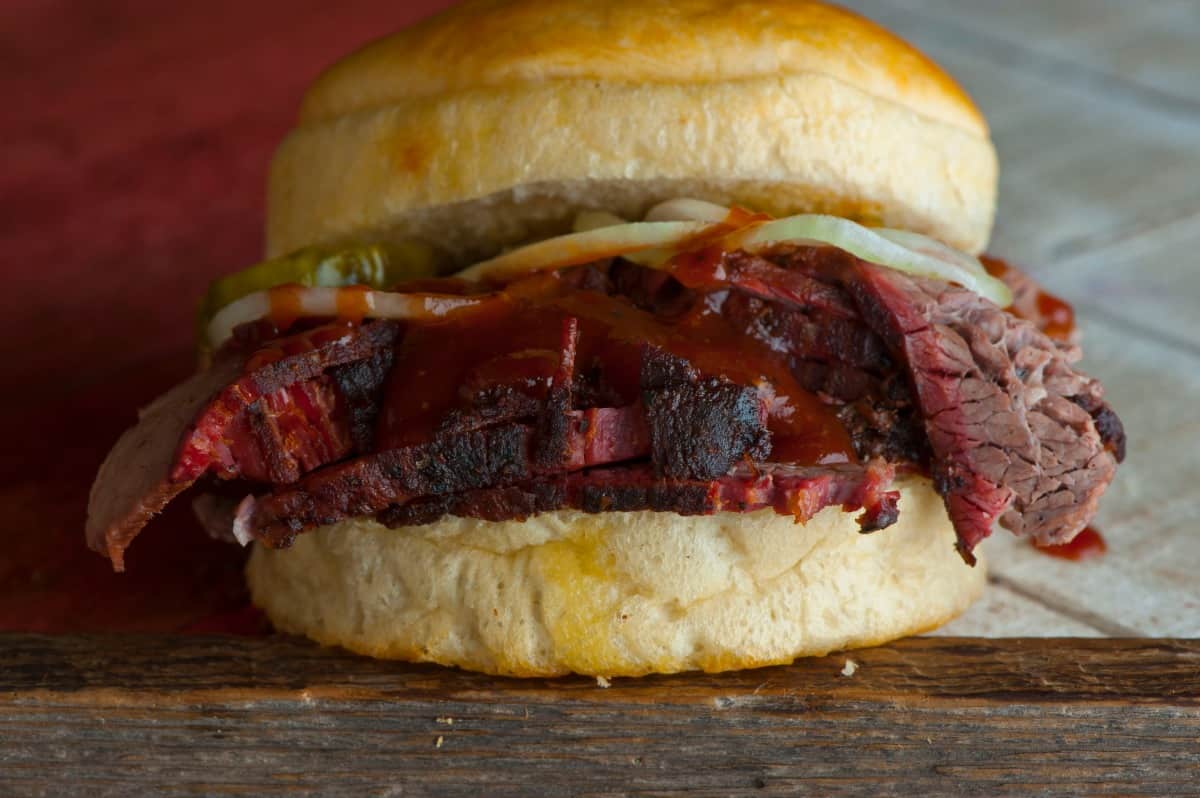
Yes. We've devoted whole articles on cutting and serving brisket, so we'll be brief here. Having and so much connective tissue, a beautifully smoked brisket can be ruined by what happens at serving time. You'll desire to:
- Cutting against the grain. Going in the direction of the meat fibers will have you back to the Days of Gnaw, as the muscle fibers. More often than not, cut quarter-inch strips for the flat and iii-eighths for the point.
- Minimize air exposure. The longer the brisket is in one slice, the longer it will hold onto its juices. A platter of brisket may make a nice picture for Instagram or Pinterest, but it will be at the cost of quickly turning your moist and tender meat dull and dry. If information technology isn't possible to slice as needed, simply go along the slices together instead of fanning them out. The less exposure to air, the slower the oxidation process (meat turns dry and chocolate-brown).
A Final Give-and-take on Safe Brisket
At that place will always be a multifariousness of temperature recommendations for cooking meats. The Food Safety and Inspection Service (a division of the U.South. Department of Agriculture) is the official setter of food cooking and storage guidelines for the state. For brisket:
- Can be refrigerated up to 5 days before cooking
- Can be frozen up to a year and retain its all-time quality
- Thaw a trimmed brisket in the refrigerator for 24 hours; a whole packer will need several days
- Cook 2 to 3 hours until the internal temperature is at least 160° F (though far college, effectually the 203° F mark for smoked brisket.)
- Permit it to stand twenty minutes before serving
- To serve hot (chafing dish, slower cooker, warming tray), keep the temperature at or above 140° F
- No more than 2 hours at room temperature (without a rut source every bit noted above)
- To serve cold (on an ice bed or pocket-sized, frequently replaced platters), go along the temperature at or below twoscore° F
- Tin be refrigerated upward to four days subsequently cooking
- Can be frozen up to 3 months subsequently cooking and retain its all-time quality
Brisket — Tough No More than
The picture painted of beef'south toughest musculus group is no longer the gray-tinted, cold and windy scenario of tough customers relentlessly gnawing on tough, leathery meat. Oh, no. The film is warm — the blue smoke, the pink of a smoke ring, and the deep dark-brown of an awesome chaff.
Brisket is the whole betoken of having a smoker, some would say. In its many forms — pastrami, corned beef, or pot roast — it has staked a permanent place on the American menu. Tried and true recipes tin can brand way for the inventive.
Nosotros hope you enjoyed your journey through beef brisket history and will share information technology with others. If y'all have a favorite recipe, please share and encourage more than of this wonderful cutting at the tabular array.
Happy grilling!
Source: https://www.foodfirefriends.com/what-is-brisket/
0 Response to "Where Does Corn Beef Come From the Cow or the Steer"
Post a Comment